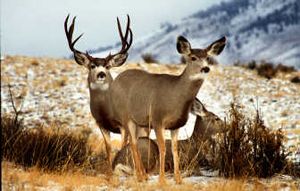Montana mule deer declining; does to be protected
HUNTING -- In what’s being called a “bold” move, the Montana Fish and Wildlife Commission gave initial approval Thursday to convert all but a few mule deer tags to antlered only, which would prohibit taking does in light of what appears to be a rapidly dwindling population, according to the Helena Independent Record.
In addition, the commission is proposing to eliminate almost all of the “B” licenses for mule deer statewide and for white-tailed deer in most of regions 4, 5 and 6; these licenses allow people to harvest more than one deer of the same species. About 30,000 B licenses were issued last year at a cost of $10 for residents and $75 for nonresidents.
The moves are supported by a wide range of hunting organizations, whose representatives noted that their members are seeing anywhere from a 60 to 90 percent drop in the number of deer on the landscape. It’s something commission members said they’ve also noticed.
Read on for more details.
According to the Independent Record:
“Usually you see 150 mule deer in my field,” Commissioner Richard Stuker of Conrad said. “This year we’re leaving the gate open in my hay fields and we haven’t seen a single one.”
Mary Ellen Schnur, a representative of the Montana Outfitters and Guides Association, said some of their members have refunded fees to clients because there weren’t any deer to hunt.
“B tag holders took 10,000 white-tailed does in 2012,” Schnur said. “That’s a lot of deer. It’s time to look at this and be supportive of this proposal.”
Montana Fish, Wildlife and Parks Director Jeff Hagener added that he’s hearing from out-of-state hunters who don’t plan to return to Montana until the deer populations have been restored.
Pulling the B licenses could cost the department upward of $300,000 in lost license fees. But the commission, department and sporting organizations said they’re looking out for the wildlife, not the money.
“Indeed, there will be a reduction in some license sales,” said George Pauley, FWP Wildlife Management Section chief. “But there’s a recognition that it's more important to properly manage deer than be concerned with revenue.”
White-tailed deer populations were decimated in the past few years by deep snow in 2010-2011 and outbreaks of epizootic hemorrhagic disease, or EHD, in recent years.
But the issues with mule deer are a bit more complicated. Marshall Johnson, the Montana and North Dakota regional director for the Mule Deer Foundation, said while the populations historically are cyclical, mule deer numbers have been dropping since the 1970s. He attributes that to a loss of habitat, including roads, energy development and urban sprawl; fire suppression that isn’t producing fresh forbs and grasses; years of drought; and a robust predator population including wolves, mountain lions and bears.
“B tags are a tool to manage for over populations,” Johnson said. “Most regions of Montana have had a problem with their populations and we agree B tags need to be pulled.”
Yet while acknowledging that there’s a problem, both Johnson and Commissioner Matthew Tourtlotte of Billings added that they’re hesitant to apply the proposed changes with a broad brush before seeing some actual numbers from this winter's surveys by wildlife biologists.
“I do have some concerns with the sweeping nature of the changes,” Tourtlotte said.
Vito Quatraro with the Montana Sportsmen Alliance also wanted to see some hard numbers before final decisions are made.
“MSA supports the recommendations for mule deer; we all recognize they’re going through some tough times,” Quatraro said. “The knee-jerk reaction from sportsmen is, it’s a good thing, but let’s give sportsmen some data. This is a sweeping change statewide. I think we need to see the numbers.”
Commission Chairman Dan Vermillion agreed,
noting that the biologists should have their surveys completed prior to a final decision being made. But the process needs to start before those numbers are available, and the final decision at the commission’s February meeting can take the science into consideration, he added.
“Science, I guess, will support the anecdotal evidence that the numbers are in tough shape,” Vermillion said. “But it’s the job of the policymakers to get ahead of the science and see if the data supports it. We are dedicated to science-based management of wildlife.”
Along with the proposed deer changes, the commission adopted tentative proposals for elk, moose, bighorn sheep, mountain goats, black bear, mountain lion, bison and game birds. In addition to taking public comment at Thursday’s meeting, FWP staff members will hold 43 meetings throughout Montana in January to present proposals to the public and receive feedback. People have until Jan. 24, 2014, to submit comments to FWP, and final adoptions will take place at the commission’s Feb. 13 meeting.
“The tentatives are the beginning of the discussion and not the final step,” Vermillion reminded about 30 people who gathered in Helena to listen to and give initial comments to the commission.
Yet members of the public urged the state agency to get people involved earlier in the process in the future and to not make the regulations so difficult to understand that people inadvertently break the law.
“A lot of groups in the state put in a lot of time looking at these, and it seems like every session there are some surprises that come up that are right in the backyard of these groups,” said Adam Barker, a sportsman from Great Falls. “If we could focus on collaboration, it would be much appreciated.”

